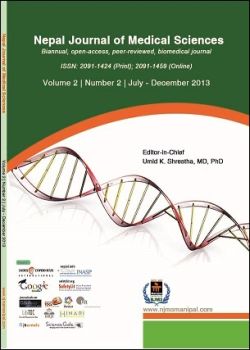Clinical Features, Management and Outcome of Snake Bite in Children in Manipal Teaching Hospital
DOI:
https://doi.org/10.3126/njms.v2i2.8954Keywords:
Anti-snake venom, hemotoxic, neurotoxic, snake-biteAbstract
Background: Snake bite is a widely distributed and neglected condition with a significant mortality. Medically significant snakes are: Elapidae, which are mainly neurotoxic and Viperidae, which are hemotoxic. Most studies on snake bites are done in Terai belt of Nepal and this is a first study of its kind in children in western region of Nepal.
Methods: This was a 7 year retrospective study in Pediatric unit of Manipal Teaching Hospital, Pokhara, Nepal. Relevant data from all cases of snake bite in children up to 18 years of age was collected in a structured proforma and analyzed.
Results: Among the 39 cases of Snake bites; it was more in boys (M: F=1.16:1), from rural areas (62%) and was more common during monsoon (64%). The commonest site of bite was foot (64%). Snakes were identifiable in only 23% of the cases. Local swelling (77%) and pain (74%) were common clinical features. Coagulation profile was deranged in 80% of the patients, hematuria was observed in 13% patients and 15% patients had thrombocytopenia. Most of the snakes were hemotoxic (77%) and only 1 case (2.5%) was neurotoxic. Only 44% of the patients received polyvalent anti-snake venom and blood products were required in 51% of the patients. Most patients improved (75%) and the case fatality rate was 2.5%.
Conclusion: Most snakes found in mountainous region of Nepal are hemotoxic and lead to deranged coagulation profile. Mortality is low in hemotoxic as compared to neurotoxic envenomations.
Nepal Journal of Medical Sciences | Volume 02 | Number 02 | July-December 2013 | Page 119-124
Downloads
Downloads
Published
How to Cite
Issue
Section
License
Copyright © by Nepal Journal of Medical Sciences. The ideas and opinions expressed by authors of articles summarized, quoted, or published in full text in this Journal represents only opinions of authors and do not necessarily reflect the official policy of Nepal Journal of Medical Sciences or the institute with which the author(s) is (are) affiliated, unless so specified.




